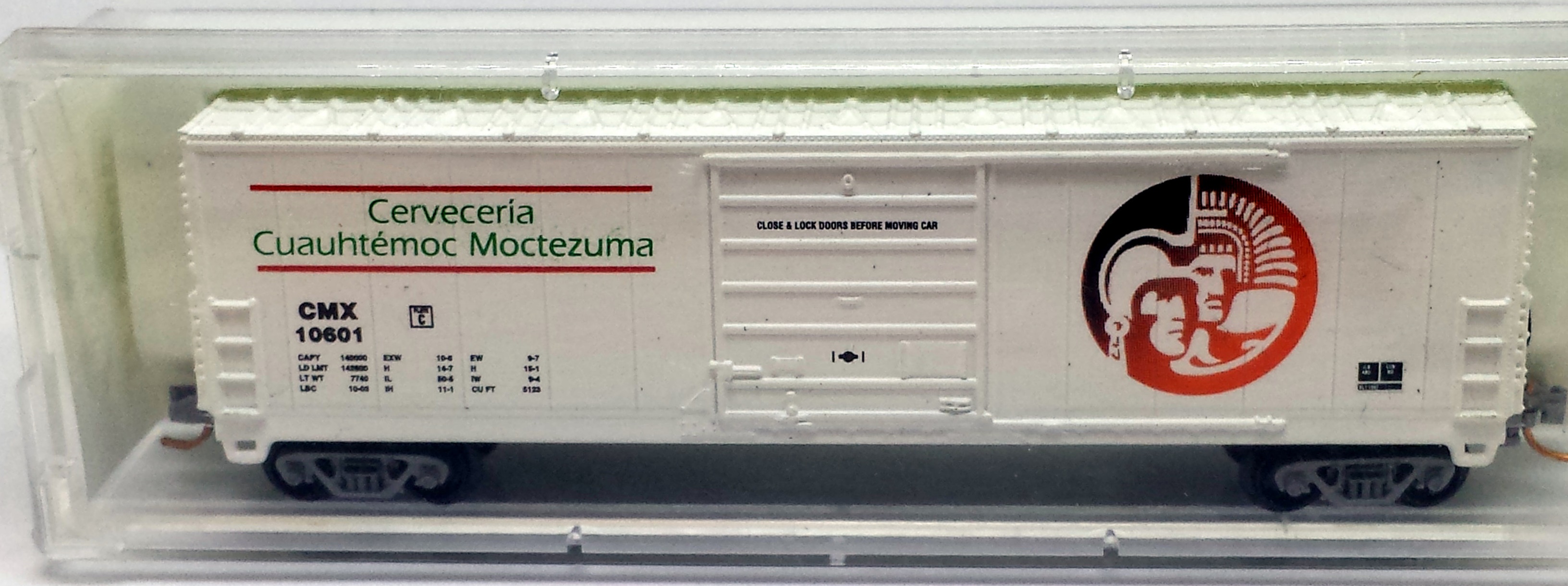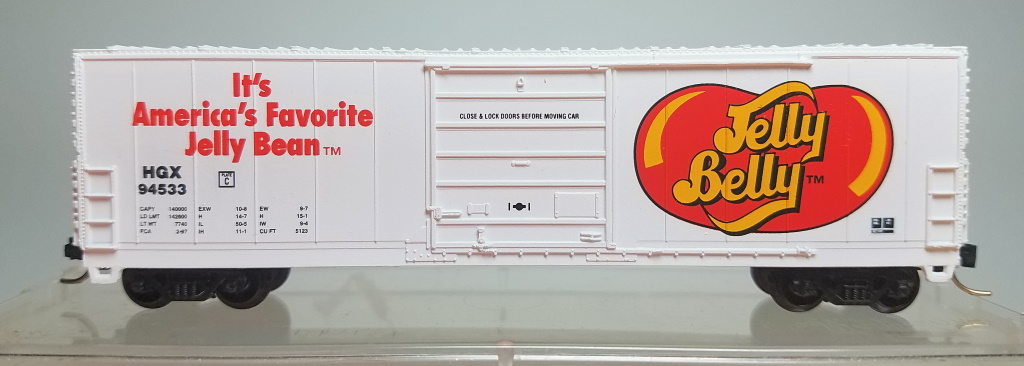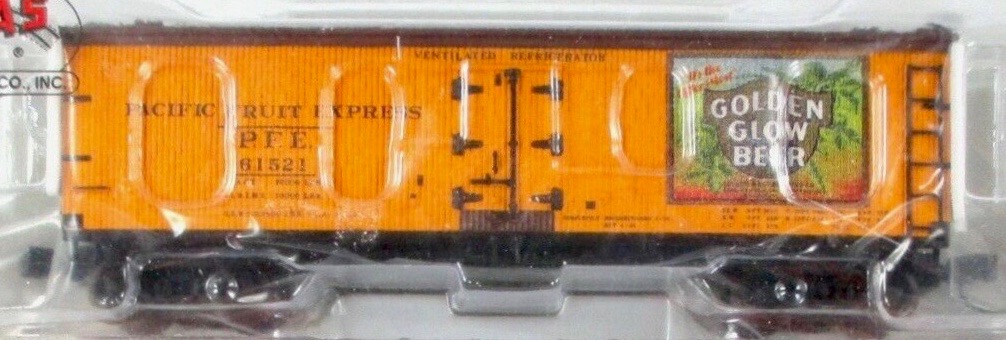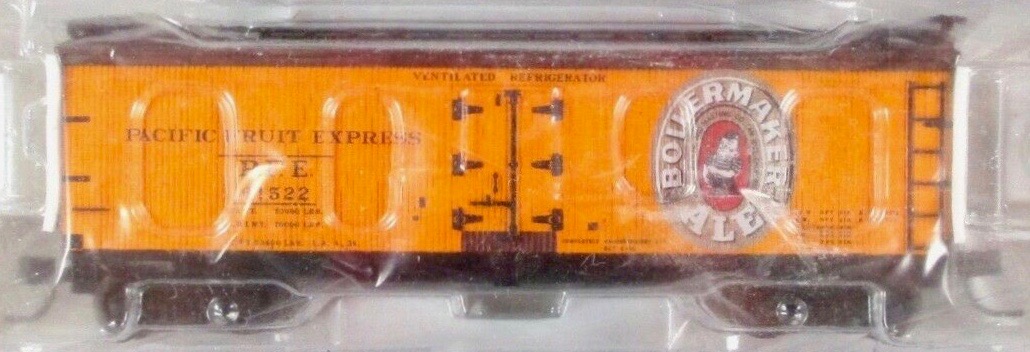Specific Item Information: Not originally sold separately. Part of NSE ATL 13-Set 1 NS Heritage, Conrail Family #1 Boxed Caboose Set, which is a five pack. containing NSE ATL 13-21, NSE ATL 13-22, NSE ATL 13-23, NSE ATL 13-24 and NSE ATL 13-25. List Price $129.95
Model Information: The Atlas "43" series cupola caboose has been around since the early 2000's. The cupola is located slightly off-center, but towards the middle of the body. It carries three windows on each body side, two larger ones at the ends and a smaller one in the middle. The cupola carries a double-window on each side. This body usually has a raised roof-walk and "loop-over" ladders but not always.
Prototype History: The origins of the railroad caboose appear to date back to the 1840s when Nat Williams, a conductor of the Auburn & Syracuse Railroad (a later affiliate of the New York Central) became fed up with cramped and uncomfortable quarters to do paperwork (a common job of the conductor, whose responsibility is general oversight and control of a train, passenger or freight), which was usually done in either a free space of a passenger car or combine/baggage car. To fix this problem, Williams found an unused boxcar and using a simple box and barrel, as a seat and desk, set up shop in the car to do his duties. Not only did he find out he had plenty of room to work but also figured that he could use the unused space to store tools (flags, lanterns, spare parts, etc.) and other essentials to have on board whenever needed (such things become commonly stored on the caboose).
Perhaps the most striking feature ever applied to the railroad caboose was its cupola. According to the story, conductor T.B. Watson of the Chicago & North Western in the 1860s reportedly used a hole in a boxcar’s roof (which he was using as a caboose) to get a better vantage point of the train ahead. It is said that Watson was amazed by the view afforded from the position being able to not only see the train ahead but also from all sides, and to the rear as well. He apparently convinced C&NW shop forces to construct a type of open observation box onto an existing singe-level caboose with windows all around where one could sit and view their surroundings. The rest, as they say, is history and the common cupola was born.
Steel Cabooses replaced their wood-sheathed brethren after the second world war when the steel glut made the production and maintenance of steel cabooses far more efficient than wooden models. With the advancement of the End-of-Train device, cabooses slowly began to fall out of favor. However, in the early 2000’s, “shoving platforms” began to appear as a place to safely house a crew when a reverse move was required. Instead of riding on the side of a freight car, the crew member now has a safe place to stand, while guiding the rear of a reverse move.
Perhaps the most striking feature ever applied to the railroad caboose was its cupola. According to the story, conductor T.B. Watson of the Chicago & North Western in the 1860s reportedly used a hole in a boxcar’s roof (which he was using as a caboose) to get a better vantage point of the train ahead. It is said that Watson was amazed by the view afforded from the position being able to not only see the train ahead but also from all sides, and to the rear as well. He apparently convinced C&NW shop forces to construct a type of open observation box onto an existing singe-level caboose with windows all around where one could sit and view their surroundings. The rest, as they say, is history and the common cupola was born.
Steel Cabooses replaced their wood-sheathed brethren after the second world war when the steel glut made the production and maintenance of steel cabooses far more efficient than wooden models. With the advancement of the End-of-Train device, cabooses slowly began to fall out of favor. However, in the early 2000’s, “shoving platforms” began to appear as a place to safely house a crew when a reverse move was required. Instead of riding on the side of a freight car, the crew member now has a safe place to stand, while guiding the rear of a reverse move.
Road Name History: Monongahela (reporting marks MGA, although their logos showed MRY until the 1970s) began around 1901 as a joint venture between Pennsylvania Railroad and Pittsburg & Lake Erie to serve a coal producing region along the Pennsylvania – West Virginia border south of Brownsville, PA. Much of the line followed its namesake river. The size of the line changed constantly as nearby shortlines were acquired, coal branches were abandoned and new ones were built. The last major addition was the Waynesburg Southern built in 1968. Mileage for the MGA system hovered around 140 miles for most of its history. They interchanged with PRR, P&LE subsidiary Pittsburgh McKeesport & Youghiogheny in Pennsylvania and with B&O in West Virginia. B&O bought a 1/3 interest in the MGA in 1927.
In the early years, more coke was hauled than coal as dozens of coke oven operations were located on the line. Monongahela did have passenger service linking the mountain communities along the line but this service ended in 1950.
The early steam fleet consisted mostly of 2-8-0’s acquired second hand from PRR and P&LE along with 4-4-0’s for passenger service. Later 2-8-0 and 2-8-2’s were built new following PRR designs. Ex-P&LE Mikes also joined the roster. The 4-4-0’s were replaced by PRR design Atlantics. The last steamer was retired in 1954.
Steam power was replaced with an all-Baldwin diesel fleet. Over several years. MGA acquired 27 S12 switchers. In 1968, they received seven RF-16 shark nose A units and two B units from P&LE parent New York Central. Like the S12’s these were painted black and kept their NYC cigar band nose stripes with the oval MRY logo added to the nose. The 1970s and 80s brought five GP38’s and nine GP7’s (long-hood-forward) to replace the Baldwins. Beginning in 1990, they received eleven B-23-7R’s from GE Capital. These were Super-7’s with the “techno-toaster” body. They arrived in a version of GE Capital’s grey “shark” scheme. Rather than repaint them black, MGA adopted the scheme adding their big red M logo and name to the nose and flanks. In May of 1993, Monongahela Railway was merged into Conrail.
In the early years, more coke was hauled than coal as dozens of coke oven operations were located on the line. Monongahela did have passenger service linking the mountain communities along the line but this service ended in 1950.
The early steam fleet consisted mostly of 2-8-0’s acquired second hand from PRR and P&LE along with 4-4-0’s for passenger service. Later 2-8-0 and 2-8-2’s were built new following PRR designs. Ex-P&LE Mikes also joined the roster. The 4-4-0’s were replaced by PRR design Atlantics. The last steamer was retired in 1954.
Steam power was replaced with an all-Baldwin diesel fleet. Over several years. MGA acquired 27 S12 switchers. In 1968, they received seven RF-16 shark nose A units and two B units from P&LE parent New York Central. Like the S12’s these were painted black and kept their NYC cigar band nose stripes with the oval MRY logo added to the nose. The 1970s and 80s brought five GP38’s and nine GP7’s (long-hood-forward) to replace the Baldwins. Beginning in 1990, they received eleven B-23-7R’s from GE Capital. These were Super-7’s with the “techno-toaster” body. They arrived in a version of GE Capital’s grey “shark” scheme. Rather than repaint them black, MGA adopted the scheme adding their big red M logo and name to the nose and flanks. In May of 1993, Monongahela Railway was merged into Conrail.
Brand/Importer Information: In 1924 Stephan Schaffan, Sr. founded the Atlas Tool Company in Newark, New Jersey. In 1933 his son, Stephan Schaffan, Jr., came to work for his father at the age of sixteen. Steve Jr. built model airplanes as a hobby and frequented a local hobby shop. Being an enterprising young man, he would often ask the owner if there was anything he could do to earn some extra spending money. Tired of listening to his requests, the hobby-store owner threw some model railroad track parts his way and said, "Here, see if you can improve on this".
In those days, railroad modelers had to assemble and build everything from scratch. Steve Jr. created a "switch kit" which sold so well, that the entire family worked on them in the basement at night, while doing business as usual in the machine shop during the day.
Subsequently, Steve Jr. engineered the stapling of rail to fiber track, along with inventing the first practical rail joiner and pre-assembled turnouts and flexible track. All of these products, and more, helped to popularize model railroading and assisted in the creation of a mass-market hobby. The budding entrepreneur quickly outgrew the limitations of a basement and small garage operation. Realizing they could actually make a living selling track and related products, Steve and his father had the first factory built in Hillside, New Jersey at 413 Florence Avenue in 1947. On September 30, 1949, the Atlas Tool Company was officially incorporated as a New Jersey company.
In 1985, Steve was honored posthumously for his inventions by the Model Railroad Industry Association and was inducted into the Model Railroad Industry Hall of Fame in Baltimore, Maryland. In addition, Steve was nominated and entered into the National Model Railroad Association Pioneers of Model Railroading in 1995.
In the early 1990s, the Atlas Tool Company changed its name to Atlas Model Railroad Company, Inc.
In those days, railroad modelers had to assemble and build everything from scratch. Steve Jr. created a "switch kit" which sold so well, that the entire family worked on them in the basement at night, while doing business as usual in the machine shop during the day.
Subsequently, Steve Jr. engineered the stapling of rail to fiber track, along with inventing the first practical rail joiner and pre-assembled turnouts and flexible track. All of these products, and more, helped to popularize model railroading and assisted in the creation of a mass-market hobby. The budding entrepreneur quickly outgrew the limitations of a basement and small garage operation. Realizing they could actually make a living selling track and related products, Steve and his father had the first factory built in Hillside, New Jersey at 413 Florence Avenue in 1947. On September 30, 1949, the Atlas Tool Company was officially incorporated as a New Jersey company.
In 1985, Steve was honored posthumously for his inventions by the Model Railroad Industry Association and was inducted into the Model Railroad Industry Hall of Fame in Baltimore, Maryland. In addition, Steve was nominated and entered into the National Model Railroad Association Pioneers of Model Railroading in 1995.
In the early 1990s, the Atlas Tool Company changed its name to Atlas Model Railroad Company, Inc.
Commissioner Information: 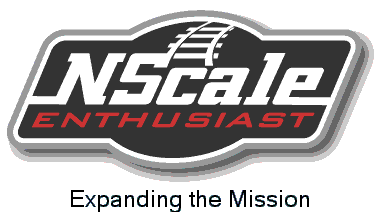 The N Scale Enthusiast Society (previously known as The N Scale Collector until 2011) was established by Wick Brandon, as a sole proprietorship and was a stand alone company until Wick passed away in 2000. The company has been owned by Micro Trains Line since then.
The N Scale Enthusiast Society (previously known as The N Scale Collector until 2011) was established by Wick Brandon, as a sole proprietorship and was a stand alone company until Wick passed away in 2000. The company has been owned by Micro Trains Line since then.
Wick was the founder of TexNRails and he established NSE right after he sold the pioneering N Scale retailer to the Herz family, and the store moved to Florida. Wick and Lea moved their family from Texas to Bakersfield California, and the entire operation was run from his home in Bakersfield. George Johnsen, the current Chairman, came on board as Associate Editor starting with the third issue of the magazine, and the growth of the organization hasn’t stopped. Wick and George did the first convention in Medford in 1993, and added staff and advisors as the organization grew. Wick held the first auction for the NSE in 1995.
The NSE mission statement reads: “This organization is dedicated to the preservation of the history of N Scale Model Railroading, and the railroads they represent.”
They do:
- Special Run Cars
- Regular Auctions of "collectable" Cars
- Annual Conventions
- Bi-Monthly Magazine
Wick was the founder of TexNRails and he established NSE right after he sold the pioneering N Scale retailer to the Herz family, and the store moved to Florida. Wick and Lea moved their family from Texas to Bakersfield California, and the entire operation was run from his home in Bakersfield. George Johnsen, the current Chairman, came on board as Associate Editor starting with the third issue of the magazine, and the growth of the organization hasn’t stopped. Wick and George did the first convention in Medford in 1993, and added staff and advisors as the organization grew. Wick held the first auction for the NSE in 1995.
The NSE mission statement reads: “This organization is dedicated to the preservation of the history of N Scale Model Railroading, and the railroads they represent.”
They do:
- Special Run Cars
- Regular Auctions of "collectable" Cars
- Annual Conventions
- Bi-Monthly Magazine
Item created by: jonmonsein on 2021-03-07 17:39:25. Last edited by Alain LM on 2021-03-08 01:37:11
If you see errors or missing data in this entry, please feel free to log in and edit it. Anyone with a Gmail account can log in instantly.
If you see errors or missing data in this entry, please feel free to log in and edit it. Anyone with a Gmail account can log in instantly.






